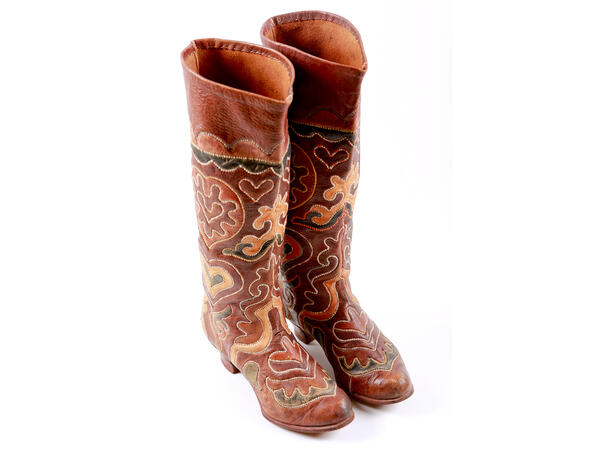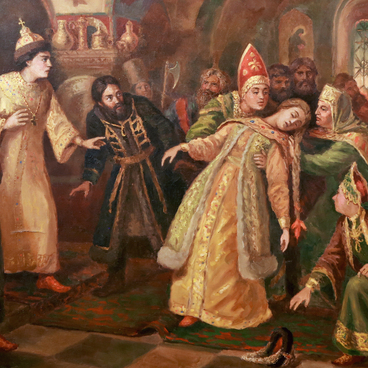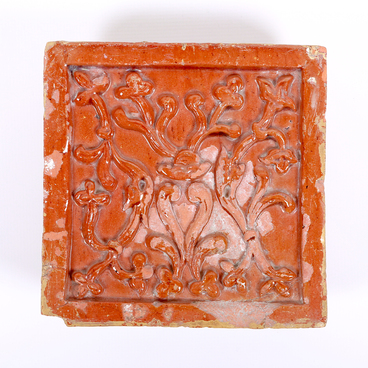The collection of the Kasimov Museum-Reserve contains ichigy — Tatar boots, which were made from multi-colored pieces of soft leather. They were sewn using a special patterned stitch, which simultaneously fastened the mosaic together and decorated the shoes.
Leather ichigy appeared in the 13th century and were part of the costume of the Kazan Tatars. Such shoes were worn by both men and women. There were everyday ichigy, usually black, and festive ones — with an abstract pattern and a unique ornament that was never repeated. They were the color accent of the outfit.
The museum houses a female model made of red leather on a small 4.5 centimeters heel. The boot top is decorated with an ornament of two multi-colored hearts of orange-yellow and dark brown color. On the front part, there are palmettes — plant patterns in the form of a palm leaf — and simple hearts.
The craftsmen who made ichigy were called artists. They made a pattern of dozens of leather fragments and fastened them with a special complex stitch — ‘Tatar stitch’. Several types of threads were used for it: cotton, silk, gold, and silver. Each point in such a stitch contained three to five loops, which were first wound on a needle, and then stretched along the front part of the shoe.
At the beginning of the 20th century, ichigy became fashionable shoes among the Russian intelligentsia. For example, the poet Marina Tsvetaeva called them ‘fabulous Kazan boots’, the actress Vera Komissarzhevskaya wore Tatar ichigy during performances at the Imperial Theater in St. Petersburg. Her shoes were custom-made. The dancer Isadora Duncan also wore ichigy: there is a photo from 1920, in which she is depicted in patterned Kazan boots with Sergey Yesenin.
Many characters in the opera performances ‘Prince Igor’, ‘Sadko’, ‘The Tsar’s Bride’ wore similar boots. When the theaters from St. Petersburg and Moscow went abroad on tour, the audience was impressed by the patterned multicolored shoes. Even the writer Alexandre Dumas in the book “The Three Musketeers” described a young lady in “Kazan house shoes”.
Leather ichigy appeared in the 13th century and were part of the costume of the Kazan Tatars. Such shoes were worn by both men and women. There were everyday ichigy, usually black, and festive ones — with an abstract pattern and a unique ornament that was never repeated. They were the color accent of the outfit.
The museum houses a female model made of red leather on a small 4.5 centimeters heel. The boot top is decorated with an ornament of two multi-colored hearts of orange-yellow and dark brown color. On the front part, there are palmettes — plant patterns in the form of a palm leaf — and simple hearts.
The craftsmen who made ichigy were called artists. They made a pattern of dozens of leather fragments and fastened them with a special complex stitch — ‘Tatar stitch’. Several types of threads were used for it: cotton, silk, gold, and silver. Each point in such a stitch contained three to five loops, which were first wound on a needle, and then stretched along the front part of the shoe.
At the beginning of the 20th century, ichigy became fashionable shoes among the Russian intelligentsia. For example, the poet Marina Tsvetaeva called them ‘fabulous Kazan boots’, the actress Vera Komissarzhevskaya wore Tatar ichigy during performances at the Imperial Theater in St. Petersburg. Her shoes were custom-made. The dancer Isadora Duncan also wore ichigy: there is a photo from 1920, in which she is depicted in patterned Kazan boots with Sergey Yesenin.
Many characters in the opera performances ‘Prince Igor’, ‘Sadko’, ‘The Tsar’s Bride’ wore similar boots. When the theaters from St. Petersburg and Moscow went abroad on tour, the audience was impressed by the patterned multicolored shoes. Even the writer Alexandre Dumas in the book “The Three Musketeers” described a young lady in “Kazan house shoes”.


